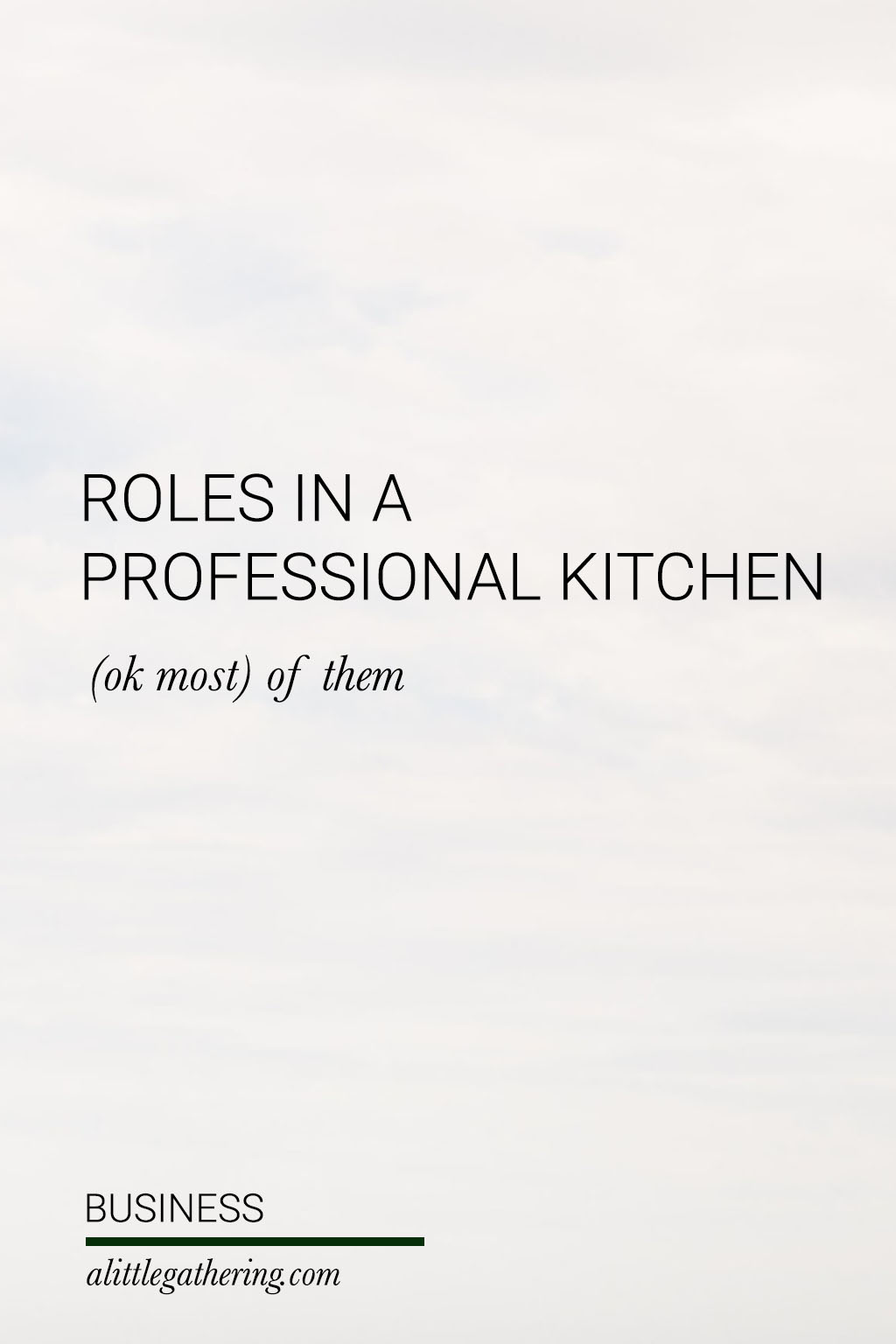Roles in a Professional Kitchen
The absolute best way to get the ins + outs of each role in a professional kitchen is to, surprise, spend time in a professional kitchen. You will learn about the industry as an insider. My way in was through working on the catering team for a quick-service lobster restaurant. Joining a restaurant part-time as a hostess or server is a great way to quickly learn about the industry.
For those of you looking for a quicker education, I made a list of the roles in a professional kitchen. Note that this is my interpretation of the roles in a professional restaurant. Each restaurant has slightly different organization, but the bones are usually the same.
The roles in a professional kitchen
Restauranteur
The head honcho, but really the person who owns the business. Everyone ultimately answers to this person, thus why some chefs choose to also own their restaurants. Sometimes this person is funding the entire restaurant or simply just calls the shots. This person typically owns the business legally, but does not have no be the original owner.
Director of Operations
The Director of Ops makes sure the restaurant, well, operates. From balancing labor costs + schedules to managing the marketing + pr—the director operations makes sure that sales go up + costs stay as low as possible. As a freelancer, you will likely interact with the director of ops way more than the restauranteur.
Manager
You know that person that comes over to your table + asks if everything is alright? That’s the Manager. A restaurant can have one manager (typically referred to as the General Manager or GM) or several who oversee service in different parts of the restaurant. Managers strive to make sure every customer is content, the floor staff is ready to go + are the go-to when a table needs extra attention.
Maitre’d + Hosts/Hostesses
The first person you see when you walk in the door is typically a Host or Hostesses and potentially a Maitre’d. The maitre’d is in charge of the hosts and hostesses. They train them + organize their schedules, but more importantly they know who is coming into the restaurant that night + guide everyone from the servers to the executive chef on how to serve diners the best. The maitre’d looks out for VIPs, from celebrities to restaurant critics. At some restaurants they keep notes on regular diners, making sure the restaurant delivers a better experience with each visit.
Executive Chef
The Executive Chef oversees the kitchen. Style differs, some chefs would rather approve dishes as they appear on the pass, while others prefer to do the cooking. They guide the menu, but often with input from the restauranteur. It takes years to become an executive chef, typically working through stations until given this prestigious title.
Sous Chef
The right hand man for the executive chef. There can be several per kitchen. Sous chefs work hard to make sure the entire kitchen is in order before + during service.
Line Cook
The worker bees of the kitchen are the line cooks. They own a station + get it done. Seafood, pasta, poultry, red meat—each station can get their own line cook depending on the size of a kitchen.
Pastry Chef
Specializing in the sweet stuff, the pastry chef plans + executes the pastry menu. They are experts in most pastry techniques: ice creams, shuffles, custards, the list is endless + delicious.
Barista/Bartender
Straightforward, but these guys are the king behind the bar. Delivering drinks throughout the day, roles around the bar range from crafting cocktails to shaking them up. They often work for tips, but typically are paid a higher hourly rate than the rest of the restaurant. They cater the front of the restaurant, while Barbacks typically take care of the drinks for those dining in the restaurant versus the bar.
Server
Aka a Waiter/Waitress, they take your orders + serve as the liaison between the diner + the kitchen. Servers work primarily for tips so hospitality is at the top of their mind. They prevent avoidable mistakes by communicating the diner’s requests from start to finish.
Runners + Bussers
Actual workhorses, they make sure everything arrives + leaves your table without you even noticing. They maintain the pacing of the meal alongside the server.
Reservationist
Making sure there is room for everyone at a restaurant is not easy work, but the Reservationist makes sure nothing goes wrong.
Catering + Events
Not every restaurant has a catering + events team, but many do. Catering is both on-site when rooms or the entire restaurant is rented. Off-site catering is also popular. Personally I am biased, but this team tends to have the most fun.
Food for Thought // There you have it, your introduction to the roles in a professional kitchen. Restaurants differ in size so there know that you won't always find the roles this clearly defined. There might be anywhere from two to a few dozen people working at one time. Again, the best way to understand what makes a restaurant tick is to spend time in one. Have you worked in restaurant? Feel free to share your favorite story from your experience below!

